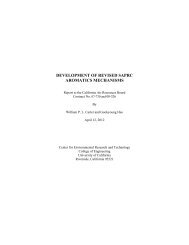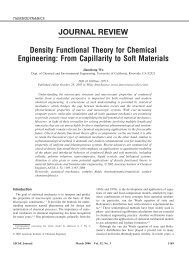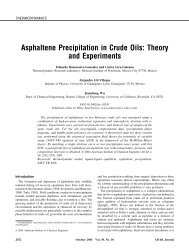Gas-Phase Ozone Oxidation of Monoterpenes: Gaseous and ...
Gas-Phase Ozone Oxidation of Monoterpenes: Gaseous and ...
Gas-Phase Ozone Oxidation of Monoterpenes: Gaseous and ...
Create successful ePaper yourself
Turn your PDF publications into a flip-book with our unique Google optimized e-Paper software.
GAS-PHASE OZONE OXIDATION OF MONOTERPENES 217<br />
Table IV.<br />
(Continued)<br />
Name Structure Pseudo-molecular ions in CI<br />
mass spectrum<br />
P 9 :C 10 H 16 O 4 M+73: 612 M+1: 540<br />
hydroxy pinonic acid M-15: 524 M-89: 450<br />
MW = 200 M-181: 358 M-197: 342<br />
deri. MW = 539 M-326: 213<br />
P 10 :C 8 H 12 O 2 M+1: 530 M-181: 349<br />
2,2-dimethyl-cyclobutane-1,3- M-197: 333 M-224: 306<br />
dicarboxaldehyde<br />
MW = 140<br />
deri. MW = 530<br />
P 11 :C 9 H 12 O 2 M+29: 571 M+1: 543<br />
3-oxo-pina ketone M-197: 345<br />
MW = 152<br />
deri. MW = 542<br />
mono-deri. MW = 347<br />
a deri. denotes derivative.<br />
b Identification confirmed with an authentic st<strong>and</strong>ard.<br />
ure 1(a) are ascribed to the mono-derivative <strong>of</strong> 3-keto-nopinone, with a MW <strong>of</strong> 347.<br />
For a dicarbonyl, PFBHA may derivatize only one <strong>of</strong> the two carbonyl groups <strong>and</strong><br />
leave the other intact if unfavorable derivatization conditions occur. Among unfavorable<br />
conditions are steric hindrance <strong>and</strong> insufficient amount <strong>of</strong> derivatization<br />
agent <strong>and</strong> reaction time.<br />
Compounds P 4 ,P 5 ,P 6 ,P 7 ,P 8 ,<strong>and</strong>P 9 have both carbonyl <strong>and</strong> OH/COOH groups<br />
(type 3 compounds), indicated by their presence in both Figures 1(a, b). Compound<br />
P 4 is tentatively identified as a hydroxy substituted nopinone, 3-hydroxy-pina<br />
ketone or 1-hydroxy-pina ketone. The derivatized form <strong>of</strong> P 4 has a MW <strong>of</strong> 421<br />
(see Figure 2-P 4 for its CI mass spectrum). Compound P 5 is tentatively identified<br />
as 2,2-dimethyl-3-formyl-cyclobutyl-methanoic acid, having a MW <strong>of</strong> 423 for its<br />
derivatized form (Figure 2-P 5 ). Three peaks, labeled P 6 in Figure 1, are identified to<br />
have a MW <strong>of</strong> 437, indicated by the presence <strong>of</strong> several pseudo-molecular ions in<br />
their CI spectrum at m/z 510, 438, 348, 256, <strong>and</strong> 240, corresponding to M+73, M+1,<br />
M-89, M-181, <strong>and</strong> M-197 (Figure 2-P 6 ). The observation <strong>of</strong> three peaks indicates<br />
that at least two isomers with the same number <strong>and</strong> type <strong>of</strong> functional groups<br />
are present. The following three isomers are possible c<strong>and</strong>idates with structures<br />
consistent with the EI <strong>and</strong> CI mass spectra fragment patterns:
















